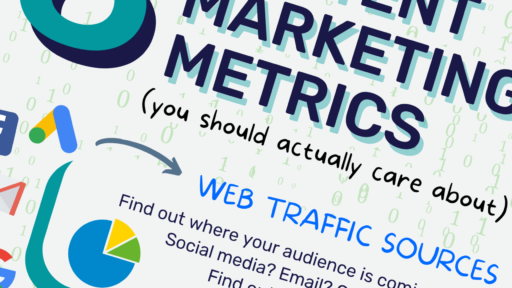Everyone wants to grow their social media presence. But do you regularly assess what you’re doing? If not, you’re not alone. All these social media marketing mistakes fall under one big audit.
It’s a simple formula. If something is working, double down. Lose anything that isn’t. Then figure out a replacement.
Social media can be overwhelming. But it’s much easier to deal with when you break it down. That way, you spot smaller problems that impact the bigger picture.
But first, you have to be honest with yourself. How many of these mistakes are you making?
- Being on too many platforms
- Not speaking like your target audience does
- Not having a strategy for each platform
- Forgetting to engage and ignoring negative comments
- Being too self-promotional
- Not directing your audience to one place
- Relying on automation
- Not creating and promoting original content
1. Being on too many social media platforms
The average person jumps between 7 different social networks a month. But that doesn’t mean your small business should do the same. And it’s a common social media marketing mistake.
Algorithms are always changing. Influencers move to other platforms. It’s hard to keep up. So, don’t spread yourself too thin. Choose your platforms wisely.
Social media management is a lot of work. So you only want to be on social platforms where you can be consistent. The only way to grow is by being committed.

Source: GIPHY
So, which should you be on? Well, it’ll depend on your industry. But here are some pulls of the most popular:
- LinkedIn is a wise choice if you’re a B2B brand
- A quarter of digital ad spend happens on Facebook
- eCommerce brands are flocking to Instagram and Pinterest
- Influencers are moving to the rapidly growing TikTok
- Twitter is the easiest place to engage with audiences
It also depends what your digital marketing goals are. If it’s brand awareness, Facebook is still most-used. If it’s engagement rates, TikTok has the highest by far at 5.96%.

Create accounts on a couple to start with. But only where you’ll be able to keep up with daily content. Fill them in fully. And stick to your strengths. Like if you’re not great with visuals, try Twitter.
2. Not speaking like your target audience does
What language do your customers use? And I don’t mean French or Spanish. (Although, matching that is a wise start.) I’m talking about your copy. Your tone.
People buy from brands they can relate to. And the fastest way to do that is to match the way they speak. Here’s what I mean:

Source: Marketing Examples
So, how do you do this? Well, it means crafting a brand voice that’s based on your target audience. You have to know which demographics you’re targeting. But more than that. Things like:
- What are their interests?
- What motivates them?
- What are their pain points?
- How much do they earn?
This takes research and data. That’s why it’s so important for your marketing team to listen to sales calls too. Because this language will be the basis of your brand’s social media presence.
It’ll be especially helpful if you use a platform like Twitter for customer support. Because it’ll dictate your tone:

Source: Groove
You also want to make sure you’re talking directly to them too. It makes it feel more personal. And people warm to it more. So, use “you” and “your” in all your copy.

Source: Basecamp
Find potential customers. Assess their lifestyles. Work out how they talk. Figure out how you can fit in. That way, they’ll be easier to market to and engage with on social media.
3. Not having a social media marketing strategy for each platform
You know you need a social media strategy. That’s a given. But your audience isn’t all on the same app.
After your research, you know who you’re targeting. So you know where they hang out.
Each site works differently. And they all attract different demographics. So, you need an effective social media strategy for each one. One of the biggest social media marketing mistakes people make is not realizing this.
Let’s take Twitter. Twitter is the place to discuss events and breaking news. So, it’s great for content marketing campaigns and engaging with your audience. But for advertising, not so great.
Here’s some recent research from Sprout Social:
| Largest global user base (Millennials make up 31.5%). Ads are still huge. But user growth rate has recently stalled. | |
| User base has doubled over 3 years to 2 billion. Mostly Gen Z and Millennials. Becoming an eCommerce hub. | |
| TikTok | Young teens make up ¼ of the users here. Plus, they spend nearly 90 mins a day on it. |
| High-earning B2B professionals make it “a potential goldmine for ads”. | |
| ⅓ of users are college-educated and make more than $75K annually. Best place to use hashtags. | |
| Mostly female users. The largest age group is 50-64. Used for researching products. |

Source: Statista
These are just a few of the main platforms. And you can see they’re all really different. So, tailor your choice to your business.
eCommerce brands may want to focus on Instagram and Pinterest. If you’ve got an awesome long-form blog, try linking to posts on Twitter or LinkedIn.
It’ll all depend on your KPIs (key performance indicators) too. Are you trying to:
- Drive traffic
- Grow brand awareness
- Engage more with your audience
- Generate leads
- Build a community
- Improve customer support
You’ll probably want to do a few of these. And your strategy for each platform will be based on these business goals. But try focus on one or two at a time. That way, you can track what’s working and what isn’t.
4. Forgetting to engage and ignoring negative comments
You can’t escape social media engagement. And you shouldn’t want to. It’s a chance to speak directly to customers. Which most brands couldn’t do back in the day.
People use social media channels to connect. With friends, family, and (now) brands. But let me ask you something. Do you expect engagement when posting content? But never engage yourself?
It’s something a lot of business owners do. But not anymore. You know you need to put the effort in with your audience. And stretch your customer experience to whatever social media profiles you’ve got.
Here are some ways to genuinely engage:
- Get involved in trending topics
- Reply to any mentions or replies
- Run contests and giveaways
- Ask thoughtful questions
- Join Q&As
- Curate content from other accounts
- Share user-generated content (UGC)
Top tip: negative feedback is always going to happen. Especially on social media. But you shouldn’t just ignore it. You just need to know how to handle it.
Trustpilot found 62% of consumers won’t support brands that censor user reviews. So, don’t try to hide them. That’s a huge social media marketing mistake in itself.
Here’s how to respond to negative comments from social media users:
- Reply quickly
- Be genuine when apologizing
- Keep it polite
- Remember retention is much cheaper than acquisition
- Direct them to your customer support channel (DMs, email, or website)
Check how Buffer does it here:
Be kind. Use the commenter’s first name to make it personal. Show you’re acknowledging the bad feedback in public. Then move the conversation out of the spotlight.
5. Being too self-promotional
This is something I’m sure you see all the time on social media. And maybe you do it yourself.
I know your Facebook page asks, “What’s on your mind?” But people don’t want to hear about it all the time. Brand or person. It doesn’t matter. Being too self-promotional is a big social media marketing mistake. And it gets boring real fast.

Source: GIPHY
I’ve mentioned a couple fixes for this already:
- Curated content
- User-generated content
But let’s have a bit more detail. You make original content yourself. Other people make curated content. You find it by searching for high-quality posts related to your industry. (Or Quuu does it for you.) Then share with your audience.
Retweeting is a really simple form. But want one hack to be instantly better than most curators? Add unique insight to everything you post. So (if we stick with Twitter), Quote the Tweet and add something alongside it.
This can be as simple as a comment:
Or you could ask a question. Or summarize the article:
By doing this, you’re adding value. You’re turning your account into a source of content from around the web. But adding your own spin. So, people want to keep coming back to see what you’ve got to say.
UGC is an even easier solution for self-promotional social media. It’s kind of the digital version of word-of-mouth marketing. And 93% of marketers agree UGC is trusted more than branded content.
Influencer marketing can be a great route to go down. But consumers find UGC 9.8x more impactful than influencer content. Plus, customers love the thrill of their favorite brand sharing their content.
It’s free and one of the easiest social media marketing efforts. And it takes the focus off you. So, get involved.
6. Not directing your target audience to one place
Social media marketing is awesome for brand awareness. But you don’t own any of it. So, if Facebook randomly deletes your account, you’re screwed. And trust me, it happens.
So, what’s the fix for this next social media marketing mistake? It’s simple. Direct them to someplace you do own.
There are 4 basic stages of the sales funnel:
- Awareness
- Interest
- Decision
- Action

Source: Hello
The thing is, every customer journey is different. So, people are constantly jumping in and out of different stages. They’re researching. Comparing. Backing out.
Social media is top of the funnel. Email marketing is in the middle. You use social media to direct people to your landing page. Then people swap email details for a lead magnet (e.g. an eBook or other resource). Or you reel them in with an awesome weekly newsletter.

Source: Marketing Examples
Either way, you want to send your audience to the same place. That way, you can keep track of the content that people open and click on. And use it to adjust your strategy.
It’s a lot harder than you think to get people to open emails. And even harder to get them to click what’s in them. So, CJ Chilvers summed up 5 steps to email better:
- Spend more time on what’s actually seen (e.g. subject line, headline, CTA button)
- Spend less time on what isn’t seen (anything below the CTA)
- Understand the “From” line delivers more ROI than any other part
- Realize the only way to improve it is through building trust with content marketing
- Invest in more content marketing and relationship building for better ROI

Content is how you’ll make people aware of your brand. And it’s how you earn their trust. So, make sure to share lots on social media.
It’s easier to get people to open content-based emails than pure marketing ones. But the tips above will give you the best shot at both.
7. Relying on automation
Automation and marketing tools are great. They take the pressure off certain tasks. And save a lot of time. They can be so handy for things like:
- Promoting a piece of content
- Scheduling social media posts
- Optimizing post times
- Chatbots for customer support
- Tracking analytics
But there are downsides to some types of automation. First of all, it’s very obvious when you use bots for social media comments. On occasion, you’ll get away with it. But Sudocrem shows how it can be a major social media marketing mistake:
This bot-like response went viral. So, a lot of other people joined in. And received the exact same response:
Yes, it’s definitely a legal thing that requires them to respond to these jokes. But even other brands were getting involved mocking them:
If you’re going to use a bot, think carefully before you do.
For most people, schedulers are the most-used social media automation tools. And they can be super helpful. But there’s a lot to be said for posting in real-time.
You can have back-and-forth conversations with customers and other brands. You can get involved in trending hashtags. You can quickly respond to complaints.
So use automation to help where it can. But let’s try keep social media social.
8. Not creating and promoting original content
I’ve talked about content’s role in the sales funnel briefly. But it really needs its own section.
You don’t control social media. But you do choose the content you share there. And how often you share it.
Original content is key for SEO (search engine optimization). But rising up the SERPs (search engine results pages) can take a long time. And you need a lot of patience.
Social media can bring much faster results. Plus, there are so many types of content you can create. Here are a few off the top of my head:
- High-quality infographics
- Short social video clips
- eBooks and whitepapers
- GIFs and memes
- Podcast episodes
- Long-form articles and blog posts

Once you’re happy, share them. Or link to them. But don’t stop there. Content isn’t going to take care of itself. You need to give it a push. Then another one. And another.
Promotion is one of the most underused tactics in social media marketing. And it’ll get your content in front of so many more people.
Here are some ideas for distributing your content on social media:
- Post your content on all platforms you’re on
- Share as part of a helpful answer on Reddit/Quora
- Break it down into a Twitter thread
- Repurpose old content into a different format
- Join relevant Facebook groups and share there
- Try ads or “Boost” posts
- Use a tool like Quuu Promote

Source: Quora
You want to try these tactics multiple times. But be smart about it. Don’t be spammy. Unless you want to lose a lot of followers. Real fast.
Conclusion
Social media marketing mistakes are everywhere. You’ve probably made a few of them yourself. I know I have. But good news, they’re all super easy to fix.
By making small changes, your accounts can stand out for the right reasons. You just need to follow this marketing plan checklist. So, make sure you:
- Pick a few platforms and stay committed
- Research and speak like your target audience
- Create a strategy for each platform you’re on
- Engage several times a day and respond to good and bad comments
- Curate content and share UGC to put the focus on others
- Direct your target audience to an email newsletter
- Set aside time to post and comment yourself
- Create original content and promote it
If you’ve got a bigger team, you can focus on more areas at once. But if it’s just you, do a bit at a time.
A/B test to find out what works and what doesn’t. Social media success won’t happen overnight. But stick with it, and you’ll see results.
Which of these social media marketing mistakes are most common? Are there any major ones we’ve missed? Tell us your thoughts in the comments below.





